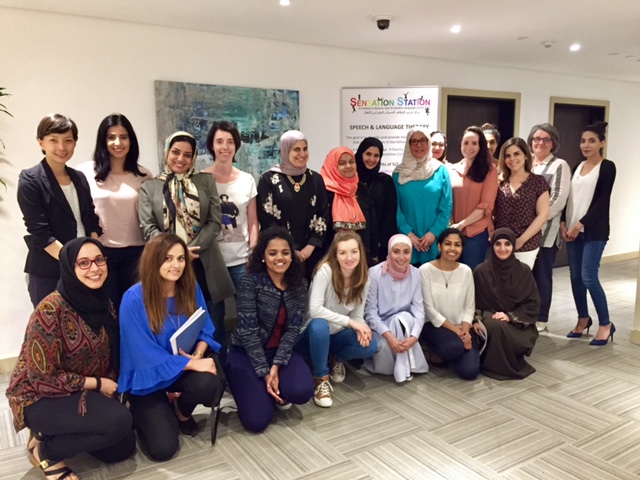THE LIDCOMBE PROGRAM
“A Behavioural Treatment For Young Children Who Stutter”

Due to popular demand, Sensation Station had organized three workshops of the amazing LIDCOMBE PROGRAM, a “Must Attend” event for Speech-Language Therapists which was accredited with 9 CPD points by Dubai Health Authority (DHA).
We had invited international speakers from the Lidcombe Program Trainers Consortium in UK and Singapore to Dubai. Overall, 70 delegates, Speech-Language Therapists from UAE, Kuwait, Saudi Arabia and other Middle Eastern countries, have attended the 2-day workshop in November 2016, April 2017 and in May 2017.

We wish to thank everyone that attended and supported us in making this event such a positive and successful experience.
What is the Lidcombe Program?
The Lidcombe Program is a behavioural treatment for young children who stutter. The program takes its name from the suburb of Sydney where the Australian Stuttering Research Centre is located, at The University of Sydney.
The treatment is administered by a parent or carer in the child’s everyday environment. Parents learn how to do the treatment from a Lidcombe trained Speech-Language Therapist. During these sessions, the Speech-Language Therapist teaches the parent by demonstrating various features of the treatment, observing the parent do the treatment, and giving the parent feedback. This parent training is essential, because it is the Speech-Language Therapist responsibility to ensure that the treatment is done appropriately and is a positive experience for the child and the family.
The treatment is direct. This means that it involves the parent commenting directly about the child’s speech. This parent feedback is overwhelmingly positive. The parent comments primarily when the child speaks without stuttering and only occasionally when the child stutters. The parent does not comment on the child’s speech all the time, but chooses specific times during the day in which to give the child feedback.
As well as learning how to give feedback effectively, the parent also learns to measure the child’s stuttering by scoring it each day. “1” is “no stuttering,” “2” is “extremely mild stuttering,” and “10” is “extremely severe stuttering.” At each clinic visit, the speech pathologist and the parent look at these severity ratings for the previous week to see what effect the treatment is having outside the clinic. This is an essential process because stuttering has to be fixed outside the clinic in the real world.
The Lidcombe Program is conducted in two stages. During Stage 1, the parent conducts the treatment each day and the parent and child attend the speech clinic once a week. This continues until stuttering either disappears or reaches an extremely low level. Stage 2 of the program starts at this point. The aim of Stage 2 is to keep stuttering away for at least one year. The use of parent feedback during Stage 2 is reduced, as is the number of clinic visits, providing that stuttering remains at the low level it was at the start of Stage 2. This maintenance part of the program is essential because it is well known that stuttering may reappear after a successful treatment.
All children and families are different, and the Speech-Language Therapist takes this into account when supervising the treatment. While the essential features of the treatment as set out in the Lidcombe Program Manual are always included, the way they are implemented is adjusted to suit each child and family.
Who uses it?
The Lidcombe Program was developed in Australia and is now used by most Speech-Language Therapist there. The manual has been translated into five languages, and these translations can be downloaded from this website. There is an international Lidcombe Program Trainers Consortium, with members in the United Kingdom, the United States, Canada, New Zealand, Denmark, Germany, the Netherlands. The Consortium has provided Lidcombe Program training to thousands of Speech-Language Therapist in those and other countries. You can read about the consortium at this website.
Does the Lidcombe Program work?
Yes, independently replicated clinical trials show that it does work to get rid of stuttering. Clinical trials have also shown that it works in a telehealth version, where the speech pathologist and family actually never meet; the treatment is done either by telephone or, more commonly these days, with Skype over the internet.
Research has also shown that the program is safe. It does not appear to interfere with parent-child relationships and has no apparent effect on other aspects of communication. Indeed, parents report that their children are more outgoing and talk more after treatment because they are no longer stuttering.
Click here for more information:
Lidcombe Program Trainers Consortium.
http://sydney.edu.au/health-sciences/asrc/clinic/parents/lidcombe.shtml
Also check out the Lidcombe video from ASRC on Vimeo: https://vimeo.com/211800077
